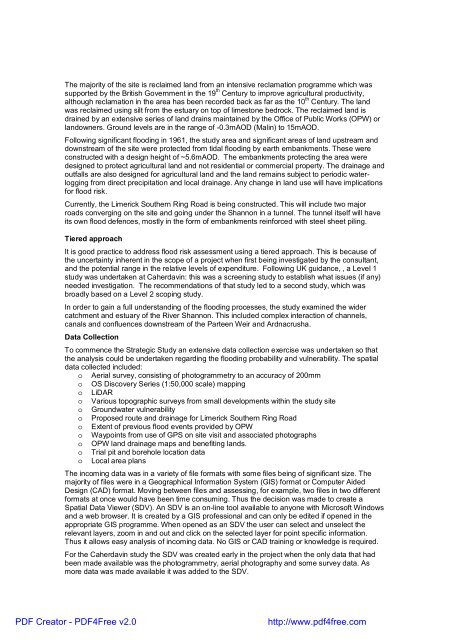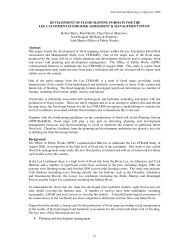Caherdavin Area Strategic Study: Flood Risk Assessment
Caherdavin Area Strategic Study: Flood Risk Assessment
Caherdavin Area Strategic Study: Flood Risk Assessment
You also want an ePaper? Increase the reach of your titles
YUMPU automatically turns print PDFs into web optimized ePapers that Google loves.
The majority of the site is reclaimed land from an intensive reclamation programme which was<br />
supported by the British Government in the 19 th Century to improve agricultural productivity,<br />
although reclamation in the area has been recorded back as far as the 10 th Century. The land<br />
was reclaimed using silt from the estuary on top of limestone bedrock. The reclaimed land is<br />
drained by an extensive series of land drains maintained by the Office of Public Works (OPW) or<br />
landowners. Ground levels are in the range of -0.3mAOD (Malin) to 15mAOD.<br />
Following significant flooding in 1961, the study area and significant areas of land upstream and<br />
downstream of the site were protected from tidal flooding by earth embankments. These were<br />
constructed with a design height of ~5.6mAOD. The embankments protecting the area were<br />
designed to protect agricultural land and not residential or commercial property. The drainage and<br />
outfalls are also designed for agricultural land and the land remains subject to periodic waterlogging<br />
from direct precipitation and local drainage. Any change in land use will have implications<br />
for flood risk.<br />
Currently, the Limerick Southern Ring Road is being constructed. This will include two major<br />
roads converging on the site and going under the Shannon in a tunnel. The tunnel itself will have<br />
its own flood defences, mostly in the form of embankments reinforced with steel sheet piling.<br />
Tiered approach<br />
It is good practice to address flood risk assessment using a tiered approach. This is because of<br />
the uncertainty inherent in the scope of a project when first being investigated by the consultant,<br />
and the potential range in the relative levels of expenditure. Following UK guidance, , a Level 1<br />
study was undertaken at <strong>Caherdavin</strong>: this was a screening study to establish what issues (if any)<br />
needed investigation. The recommendations of that study led to a second study, which was<br />
broadly based on a Level 2 scoping study.<br />
In order to gain a full understanding of the flooding processes, the study examined the wider<br />
catchment and estuary of the River Shannon. This included complex interaction of channels,<br />
canals and confluences downstream of the Parteen Weir and Ardnacrusha.<br />
Data Collection<br />
To commence the <strong>Strategic</strong> <strong>Study</strong> an extensive data collection exercise was undertaken so that<br />
the analysis could be undertaken regarding the flooding probability and vulnerability. The spatial<br />
data collected included:<br />
o Aerial survey, consisting of photogrammetry to an accuracy of 200mm<br />
o OS Discovery Series (1:50,000 scale) mapping<br />
o LiDAR<br />
o Various topographic surveys from small developments within the study site<br />
o Groundwater vulnerability<br />
o Proposed route and drainage for Limerick Southern Ring Road<br />
o Extent of previous flood events provided by OPW<br />
o Waypoints from use of GPS on site visit and associated photographs<br />
o OPW land drainage maps and benefiting lands.<br />
o Trial pit and borehole location data<br />
o Local area plans<br />
The incoming data was in a variety of file formats with some files being of significant size. The<br />
majority of files were in a Geographical Information System (GIS) format or Computer Aided<br />
Design (CAD) format. Moving between files and assessing, for example, two files in two different<br />
formats at once would have been time consuming. Thus the decision was made to create a<br />
Spatial Data Viewer (SDV). An SDV is an on-line tool available to anyone with Microsoft Windows<br />
and a web browser. It is created by a GIS professional and can only be edited if opened in the<br />
appropriate GIS programme. When opened as an SDV the user can select and unselect the<br />
relevant layers, zoom in and out and click on the selected layer for point specific information.<br />
Thus it allows easy analysis of incoming data. No GIS or CAD training or knowledge is required.<br />
For the <strong>Caherdavin</strong> study the SDV was created early in the project when the only data that had<br />
been made available was the photogrammetry, aerial photography and some survey data. As<br />
more data was made available it was added to the SDV.<br />
PDF Creator - PDF4Free v2.0<br />
http://www.pdf4free.com
















